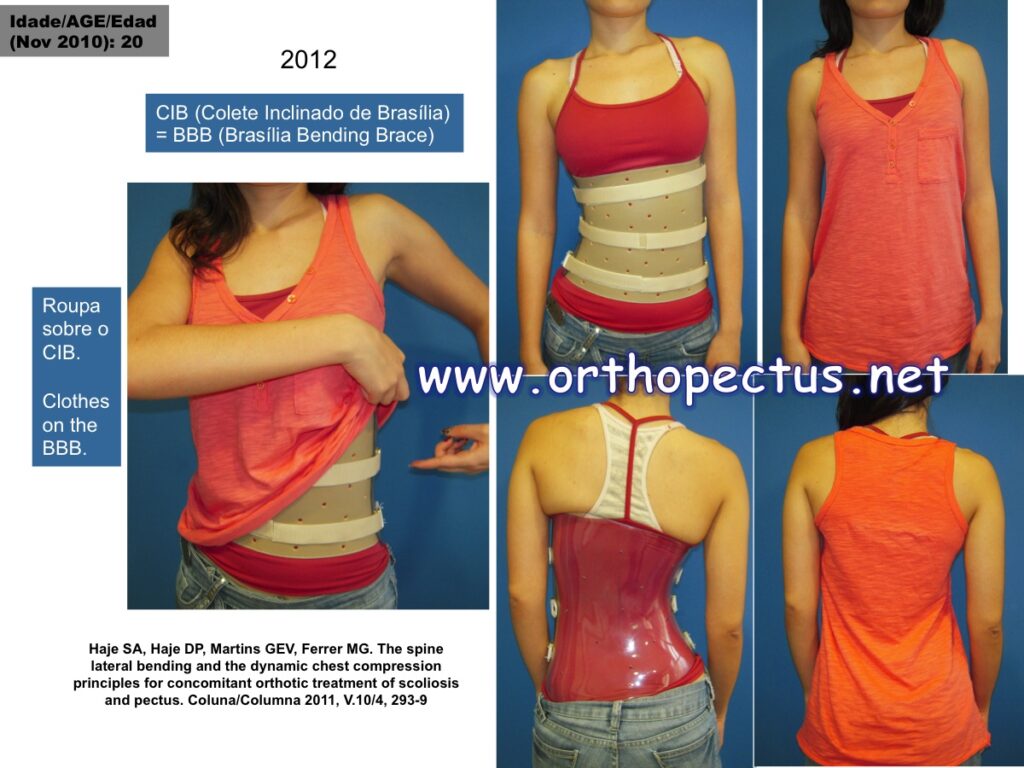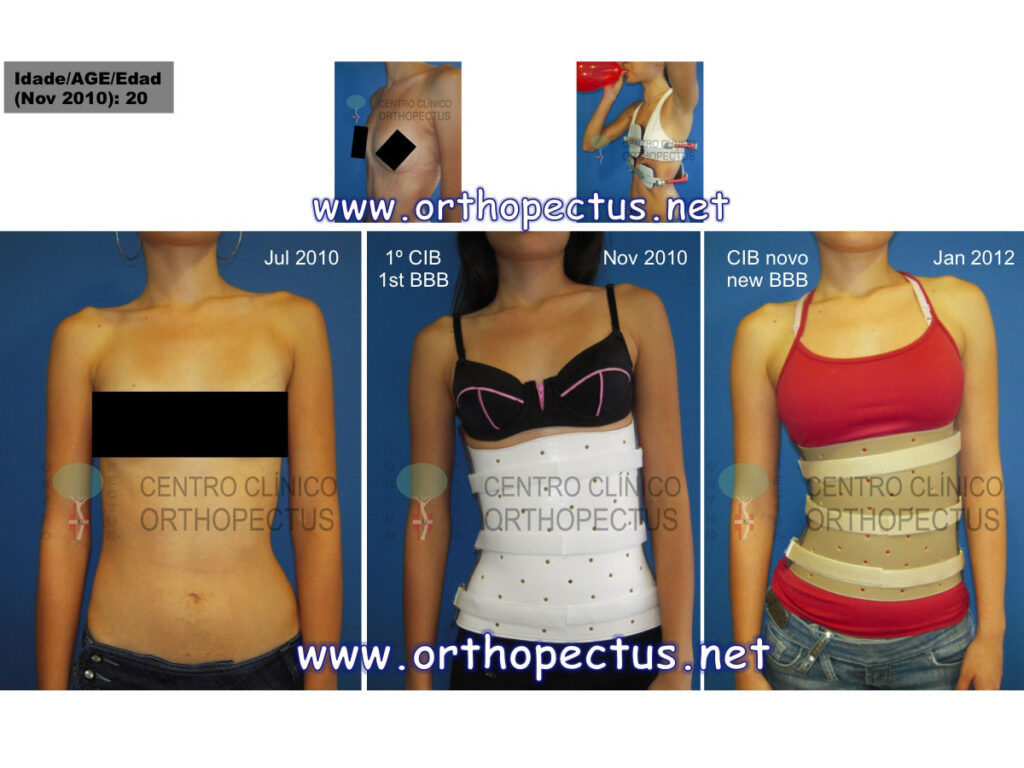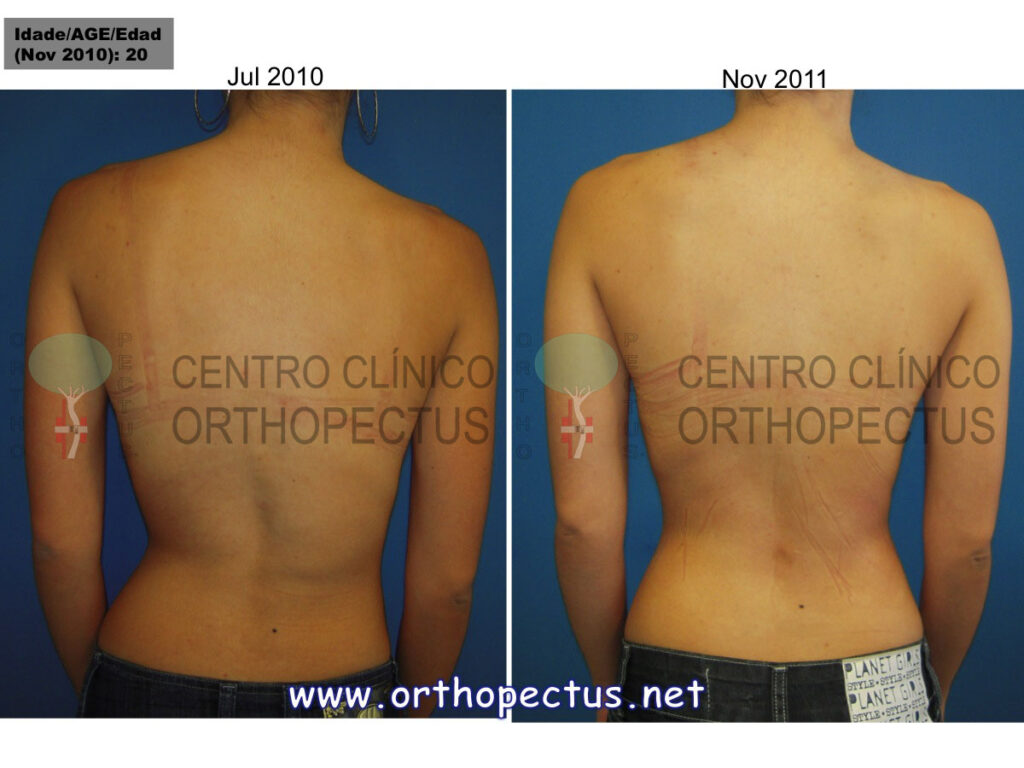Scoliosis Treatment
What can be done if the pectus patient also presents a SCOLIOSIS, a lateral curvature of the spine?
1) When the scoliosis is slight and with no significant vertebral rotation, sometimes only The Dynamic Remodeling Method [Dynamic Chest Compressor (DCC) orthoses along with exercises helps. An improvement of both conditions, pectus and scoliosis, usually takes place in compliant patients, who follow strictly the medical instructions, as shown in the example below.

2) When the scoliosis is moderate, with a curvature higher than 20º and/or with rotational component, we associate a spine brace appropriated for the case. Usually, in this situation, we recommend wearing of the DCC from 2 to 6 hours (average of 4 hours) a day and practice of the prescribed exercises with the chest brace(s) on the patient, for about one hour in that period of the day; the brace for the spine should be worn for the rest of the day (around 19 hours a day). The spine brace we use is the Brasilia Bending Brace or BBB – made after a plaster cast mold – see examples below and see published article on the treatment of scoliosis using the bending principle (see article). Our method to treat scoliosis is also DYNAMIC, involving regular practice of an exercise program, that includes lateral bending of the spine in greater number of times to the convexity side of the main curve, and a progressive bending of the BBB, made from molds that aim a progressive correction, at least once a year (see examples below). The doctor makes the lateral tilt of the spine during the plaster cast molding based on previous radiographic analysis. The differences between the Brasilia Bending Brace, an orthosis for day and night use, and the Charleston Bending Brace, an orthosis for use only during the night.

3) Once the side bending exercises are done correctly as a daily routine, an increase in the flexibility of the curvature occurs with time,usually decreasing the Cobb angle measured in radiographs. This way, manufacturing of a new BBB for additional correction can be made. Clinically the correction is better observed on the flanks of the patient’s trunk. The shoulders level difference while the patient is wearing the BBB is not important. It improves when the patient is out of the brace. Radiographic analysis proves the clinical improvement.

4) See below case published in the article Haje SA, Haje DP (2009) Abordagem ortopédica das deformidades pectus: 32 anos de estudos (Orthopaedic approach to pectus deformities: 32 years of studies).Revista Brasileira de Ortopedia; Vol 44/3: 193-200. View online. From that time, with 40 months follow-up, the patient was released from the DCC braces and started weaning from the BBB. Her 60 month evolution was described and shown in the article Haje SA, Haje DP, Martins GEV, Ferrer MG. The spine lateral bending and the dynamic chest compression principles for concomitant orthotic treatment of scoliosis and pectus deformities. Coluna/Columna 2011; Vol10(4):293-9. View online.


5) The BBB, which is made from a plaster cast molded with a lateral corrective tilt of the patient’s trunk (see it in the second figure of this section), brings more comfort to the patient when compared to other braces made from casts molded under longitudinal traction. The BBB follows biomechanical principles (see aforementioned articles). One of the reasons for the patient compliance in a long-term follow-up is the good adaptation of the BBB to his/her body. The brace remains very well hidden and it is not noted under the clothes.

6) Another positive factor for compliance is the progressive improvement seen by the patients on the clinical photographs. Their effort is rewarded when they compare the initial clinical picture with the current one. The clinical improvement comes through not only from the decrease in the scoliosis angular value, but also from the improvement in the vertebrae rotational component, a biomechanical principle resultant from the affected spine segment side bending. The spine flexibility is more important than skeletal maturity (Risser sign) in scoliosis treatment by this method. Such concepts and the treatment protocol are described.




7) We do not know the maximal degree of scoliosis that our method can treat. Side bending radiographs are useful for prognosis and thoracolumbar single curves present better response to the method. In the case shown below, for instance, the pre-treatment radiograph showed an improvement of more than 50% in the lateral bending to the side of the convexity (right side), encouraging us to treat him. In just three months of dedication to our method one could note in x-rays with the patient out of the brace an improvement from 73º to 57º in the Cobb angle. Some clinical improvement could also be noted (see pre and post flanks of the patient). If by any reason the patient gives up the conservative attempt, a surgical approach is indicated. In this situation, we believe that the improvement in the spine flexibility previously obtained by the Haje’s method will contribute for the operative technique and for the best possible result.

8) The patient above proved to be very motivated to continue with this conservative treatment that includes daily exercise with selective side slopes . In June 2012 , before returning to their country of origin, Ukraine, received new Tilted Collect Brasilia (CIB), made by plaster cast mold seeking progress on corrective lateral slope (see below).

